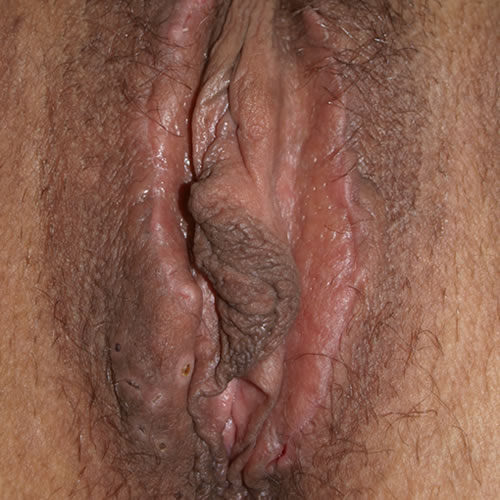Introduction
Syringoma is a benign adnexal tumor derived from the eccrine sweat ducts. 1 Multiple, small, firm, flesh colored papules are most commonly located on the face (periorbital area) and neck. The papules have rounded or flat-topped surfaces and may be pruritic. Other areas involved are cheeks, axillae, abdomen, and genitals. 2
Epidemiology
Their occurrence is twice as common in women than men. Involvement of the vulva is relatively rare and usually occurs in young women after puberty.3 However, further lesions can develop later in life, and reported cases range between the first and sixth decades of life. 4
Etiology
The etiology of syringoma is not known.5 The inflammatory process seen around the eccrine ducts may be secondary to neoplastic proliferation of ducts. It has also been hypothesized that the growth of syringoma is under hormonal influence, but a study found no expression of estrogen or progesterone receptors in 15 patients. 6
Symptoms and clinical features
The most common presentation is that of multiple skin colored or brownish and yellowish papules on the labia majora that may be associated with intense pruritus or distress.7 Sweating and hyperhydrosis add to the irritation. The papules are recurrent.

Diagnosis
Biopsy is necessary.
Pathology/laboratory findings
Histologically, syringomas show normal epidermis with numerous dermal tumors, sometimes with deep extension.8 They are composed of multiple small ducts of the eccrine type, usually lined by two layers of cuboidal epithelium. Some of the ducts possess a small comma like tail of epithelial cells giving the appearance of a tadpole. Solid nests and strands of cells with a basaloid appearance may be present. Surrounding stroma may be fibrotic. 9
Differential diagnosis
Differential diagnosis includes epidermoid cysts, steatocystoma multiplex, early condyloma, VIN, Paget disease, psoriasis, tinea cruris, drug reaction, Fox-Fordyce disease, lymphangioma circumscriptum, angiokeratoma, and molluscum contagiosum.
Treatment/management
Treatment of syringoma must be multifaceted, designed to eliminate the lesions and stop the sweating, irritation and scratching.
Women need education to accept some degree of labial surface irregularity or “bumpiness.”
Destruction of the papules carbon dioxide (CO2) laser, argon laser, 585-nm and 595-nm pulsed dye laser, erbium-YAG laser is performed deep enough to remove the lesions but not to extend to the hair follicles. Skinning vulvectomy and cryotherapy are also successful.
Botox injections may used to stop sweating and help pruritus.
Compounded atropine 1% with glycopyrrolate 0.1% or ciclopirox 0.77% with glycopyrrolate 0.1% applied twice daily also improves sweating and itching.
Scratching may be controlled with topical steroids such as clobetasol 0.05% ointment applied in a thin film twice daily for 30 days, then once or twice weekly. If steroids are not effective, central nervous system control may be necessary with an SSNRI. Oral and topical retinoids may also be useful.
References
- Jamalipour M, Heidarpour M, Rajabi P. Generalized eruptive syringomas. Indian J Dermatol. 2009;54:65-67.
- Tawade YV, Pradhan AM, Gharpuray MB, Shete S. Syringoma of the Vulva. Indian J Dermatol Venereol Leprol. 2000;66:326-327.
- Gutte RM, Chikhalkar S, Khopkar U. Unknown: Multiple asymptomatic skin colored to yellowish papules over vulva. Dermatol Online J. 2011 Aug 15;17(8):7.
- Belardi MG, Maglione MA, Vighi S, di Paola GR. Syringoma of the vulva: a case report. J Reprod Med 1994; 39:957-959.
- Gutte RM, Chikhalkar S, Khopkar U. Unknown: Multiple asymptomatic skin colored to yellowish papules over vulva. Dermatol Online J. 2011 Aug 15;17(8):7.
- Huang Y, Chuang Y, Kuo T, Yang L, Hong H. Vulvar syringoma: A clinicopathologic and immunohistologic study of 18 patients and results of treatment.J Am Acad Dermatol. 2003;48:735-739
- Rama Rao GR, Rani RR, Amareswar A, Krishnam Raju PV, Kumari PR et al. Multiple papules on the vulva. Indian J Dermatol Venereol Leprol. 2008;74:185-186.
- Kazakov DV, Bouda J Jr, Kacerovska D, Michal M. Vulvar syringomas with deep extension: a potential histopathologic mimic of microcystic adnexal carcinoma. Int J Gynecol Pathol. 2011 Jan;30(1):92-94.
- Seirafi HH, Akhyani M, Naraghi ZS, Manssori P, Dehkordi HS et al. Eruptive syringoma. Dermatol online J. 2005;11(2):13.